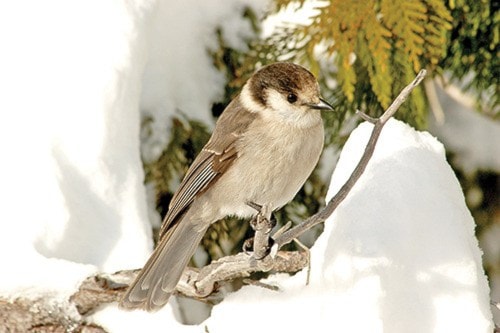The Whisky Jack, also known as the Grey jay or the Canadian jay, may soon become Canada’s national bird.
In January of 2015, the team at Canadian Geographic founded the National Bird Project, asking Canadians to vote for an official bird for Canada by the country’s 150th anniversary of Confederation.
Almost 50,000 people answered, voting for their favourite bird.
The Royal Canadian Geographical Society later convened a panel of experts the following year, and saw Minister of the Environment and Climate Change Catherine McKenna provide opening remarks about the importance of birds in Canada.
On Nov. 16, 2016, the Society made its official recommendation for Canada’s National Bird — the Grey jay.
Of those advocating for this bird is North Saanich resident and Ameritus Professor of Wildlife Biology for McGill University, David Bird.
His reasoning for choosing this particular bird was lengthy, but came down to three main reasons.
“Probably the main reason is it’s found in every province, every territory and the range of this bird is such that it almost mirrors our borders,” he told the PNR.
The bird, he said, goes into Alaska a little bit and down into the pacific northwest, but by in large its a bird that’s mostly found in Canada.
His second reason is that the bird has attributes that he feels characterizes the Canadian spirit and character. He said it’s an extremely smart bird as it belongs to a family of birds that also includes crows, jays, magpies and ravens, which are some of the smarter birds on the planet.
The jay is also a friendly bird, he said, as it will come up to humans who are in close range and sit on their hands.
“And they’re not obnoxious about it,” said Bird. “They’re not like gulls at a fast food joint that can take a kids finger off ...”
They’re also tough, as they don’t migrate out of Canada like almost all other birds do in the winter time.
“They stay in their territory year ‘round and they will actually sit on their eggs at -30 degrees, so this is a bird that sits on its eggs sometimes covered in snow.”
In fact, he said, they’re getting ready to nest right now and will probably be nesting in the next month.
Another lesser known feature of the Grey jay, because they stay around year ‘round, is they stay with their mate and don’t cheat on them.
They are also good at storing food and can store as many as 5,000 items in a day.
A minor thing about them to consider, Bird said, is that they’re not an endangered species or a hunted species.
This, he said, is why he didn’t think the Canada Goose should be represented as Canada’s national bird.
“Would we want to have a national bird that we’re shooting because it’s obnoxious? I don’t think so.”
In the top five behind the Grey jay were the Common loon, Snowy owl, Canada goose and the Black-Capped chickadee.
His argument in the debate was that a lot of these birds belonged to specific provinces; the Snowy owl to Quebec, the Common loon to Ontario, etc.
So, he argued, why not leave them alone and pick something fresh and new for their Canadian bird?
“It’s a great poster child for climate change. It’s also a great poster child for our boreal forest because that’s where it lives. It’s also a great poster child for our national parks and provincial parks because that’s also the best places to go and see it,” said Bird.
In the Mount Washington parking lot of the ski resort is where one can witness one of these birds on Vancouver Island — if they were to hold out their hand.
Although not a bird one will see everyday, it will sometimes visit Canadians while skiing, hiking and camping in the boreal forests and parks. Bird said it will get people to appreciate it enough and want to fight to keep it around, while making sure the boreal forests and parks are preserved.
The Royal Canadian Geographical Society will now lobby the federal government for adoption of the Grey jay to be known as Canada’s national bird.
As for Bird’s stance, he urges people to write to McKenna to encourage the selection of the Grey jay at Catherine.McKenna@parl.gc.ca
